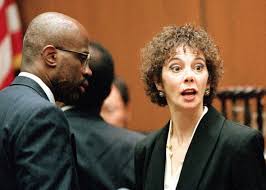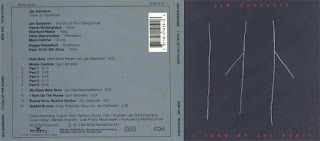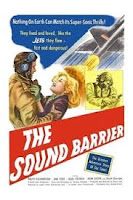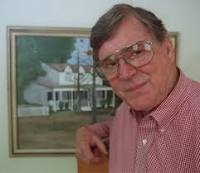 I wrote the following piece from Los Angeles for the Financial Times. It appeared in the FT, in somewhat more restrained form, on 27 February 1999. The hardest part was getting accredited, for some reason they didn't quite believe I came from London, or wrote for the FT, or maybe both. But there I am, about four rows back; you can see me more clearly in the second photo, below left. And by the way, the FT didn't use that title for the piece.
I wrote the following piece from Los Angeles for the Financial Times. It appeared in the FT, in somewhat more restrained form, on 27 February 1999. The hardest part was getting accredited, for some reason they didn't quite believe I came from London, or wrote for the FT, or maybe both. But there I am, about four rows back; you can see me more clearly in the second photo, below left. And by the way, the FT didn't use that title for the piece.
The OJ Simpson Circus was back in action in Hollywood last week, when
property from the former football star’s residence was auctioned off on
behalf of a Court Receiver, one step in obtaining the $33.5 million
judgement levied against Simpson by a Santa Monica jury in the civil
suit brought by the families of Nicole Brown and Ron Goldman. This
being LA, the receiver, Michael D. Myers, came complete with a
four-page biographical press release, describing himself as “slim
and soft-spoken”.
 Sadly, the slim and soft-spoken Mr. Myers went overlooked by the local media, for whom otherwise it was
Christmas in February. Hollywood auctioneers Butterfield &
Butterfield on Sunset Boulevard overflowed with 17 film crews
jostling, 12 reporters pouting, 8 live-vans transmitting, and 5
panicked PRs. All it was missing was Dominick Dunne as the partridge
in the front row.
Sadly, the slim and soft-spoken Mr. Myers went overlooked by the local media, for whom otherwise it was
Christmas in February. Hollywood auctioneers Butterfield &
Butterfield on Sunset Boulevard overflowed with 17 film crews
jostling, 12 reporters pouting, 8 live-vans transmitting, and 5
panicked PRs. All it was missing was Dominick Dunne as the partridge
in the front row.
The top item on offer was OJ’s 1968 Heisman Trophy, awarded by the
New York Athletic Club to America’s outstanding college gridiron
player, and made more valuable because the Club misspelled Athletic
on the inscription. Beyond
the contents of his trophy room, the sale also provided a rare look
into the aesthetic sensibilities of the football star turned Hertz pitchman and Naked Gun actor. Tiffany
style lamps, chocolate box tourist paintings, and a large
proto-cubist head painted by Donna Summer all gathered more action
than many of the sports items.
The crush of media necessitated a second room for buyers and the
curious public, including those desperate for their 15 seconds of
fame. Hogging the centre ring of the circus was one Bob Enyart, a
right-wing radio host from Denver, who orchestrated a TV camera scrum
by announcing he would destroy the three items he purchased in a ceremony on
the steps of the LA courthouse the next day at high noon. Enyart
claimed to be acting for “citizens frustrated with the American
justice system that allowed a criminal to remain as President and a
murderer to go free.” Meanwhile, he frantically plugged his
web-site, which turned out to be hawking “I Helped Execute OJ
Simpson” T-shirts for a mere $200 a pop.  As it turned out,
Enyart’s OJ exorcism was exiled to the “and finally” item on
the next night’s news.
As it turned out,
Enyart’s OJ exorcism was exiled to the “and finally” item on
the next night’s news.
 As it turned out,
Enyart’s OJ exorcism was exiled to the “and finally” item on
the next night’s news.
As it turned out,
Enyart’s OJ exorcism was exiled to the “and finally” item on
the next night’s news.
Other buyers included wealthy souvenir seekers like Marty Cohen, who
dropped out of the Heisman bidding at $220,000 “when rationality
took over” and, more predictably, sports collectors, like Mark
Dalen. Dalen came from Michigan, wearing proudly a huge Super Bowl
winners’ ring he’d bought off the bankrupt family of former
Chicago Bears owner George Halas. “Financial problems are sad,
but they’re good news for collectors,” he said, adding he’d
bought, and resold, a second Bears’ ring he after it was pawned by
the son of a team executive, in his words, 'to pay off drug dealers'. Dalen proved a less than Super Bowl quality bidder, winding up only with OJ’s
commemorative NFL Alumni golf umbrella, a snip at $400. That was the
only golf umbrella on auction, but six separate sets of Simpson golf
clubs sold for $2000 or $2250 each. OJ must’ve insisted on one
day of golfing rest.
And of course, there were the OJunkies who had queued for hours to get a place in
the room. Yvonne Adler had attended the civil trial every day for six
weeks, and now wanted to buy something to burn. Priced out of the
early bidding, she tried to pool with three other women, familiar to
each other from the trial, to buy and share a collection of four
crystal awards. But one of the four refused, on the grounds crystal
doesn’t burn.
The usual absentee and telephone buyers were joined by bidders on the
internet. The auction was transmitted live over Yahoo.com, and
featured interactive “real time” bidding, using systems developed
by the Seattle-based LiveBid. LiveBid has already run 40 internet
auctions, selling, among other things, the Batmobile from the movie Batman Returns. CEO Matt Williams, 26, admitted they were doing this
one for the exposure. The question was, for whom? As Williams said, 'the prospect of riding the OJ media whirl
“gave me goose bumps.”
Internet buyers bought three items, and the crush of bidding
threatened to overwhelm Yahoo’s Susan Carls, on the computer in
the auction room. “It’s pretty scientific,” she said modestly.
“The system takes only the highest bid, and automatically
eliminates others. But I was really hoping we’d win the
next-to-the-last item.” An internet buyer had appeared to claim The Washington Pigskin Club’s
Player of the Year trophy, but a late bid from the second room
coincided with auctioneer Scott Bradley’s dropping the hammer. "I
felt it appropriate to allow the bid," said Bradley, who otherwise coped
with the myriad sources with aplomb, to no one's surprise. "Potentially, we can add
millions of bidders, but there’s weren’t really any problems."
 The piece de resistence, the Heisman Trophy went by phone to a then-anonymous
buyer for $230,000. Two days later, Philadelphia sheet-metal
wholesaler Tom Kriessman, 47, flew to LA to ante up $255,000
(including tax and comission) for his first-ever sports collectable.
"I bought it for everything it represents," he said. "You
know, the tragedy that was his life." Not to mention his victims.
The piece de resistence, the Heisman Trophy went by phone to a then-anonymous
buyer for $230,000. Two days later, Philadelphia sheet-metal
wholesaler Tom Kriessman, 47, flew to LA to ante up $255,000
(including tax and comission) for his first-ever sports collectable.
"I bought it for everything it represents," he said. "You
know, the tragedy that was his life." Not to mention his victims.
The sales of OJ’s other tchatkes totaled $152,000. Nicole Simpson’s
father, Lou Brown (see photo top left), watched the sale from the front row. Attorney
Gary Caris announced afterwards that Brown was "very pleased
with the result, but very pleased it was over." They remain
aware that the $382,000 raised represents just over 1% of the
judgement owed the two families, and that’s before the slim and
soft-spoken Mr. Myers’ fees.OJ himself has decamped to Florida, where state law protects more assets against civil judgements.
Ending the post-sale press conference, Butterfield’s George Noceti,
compared the Simpson auction to his past successes with Liberace or
Elvis. And with that, the OJ media circus folded its tents, and
Butterfield’s business resumed, auctioning television and movie memorabilia,
starting appropriately enough with costumes from the cult TV show The
Munsters.




















